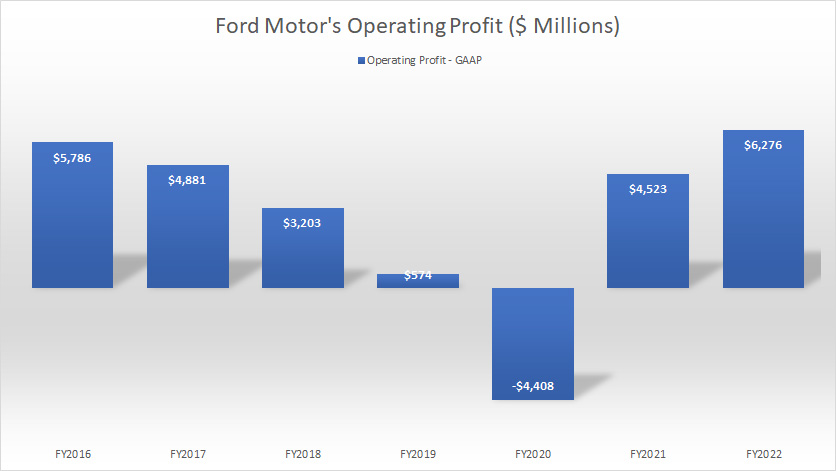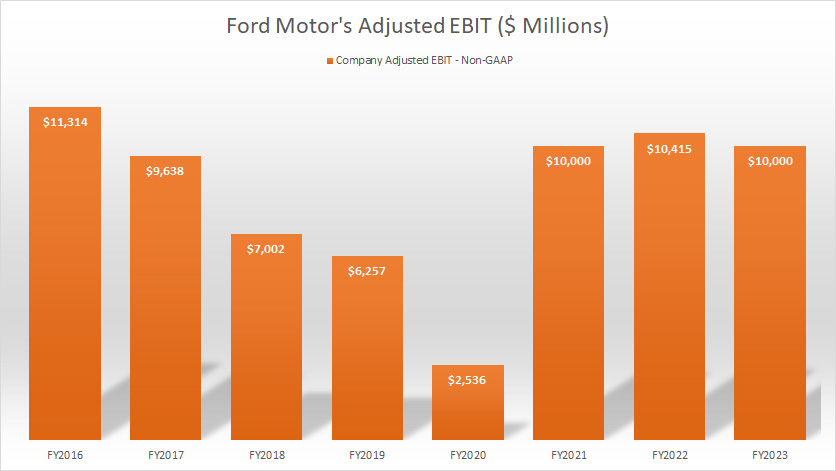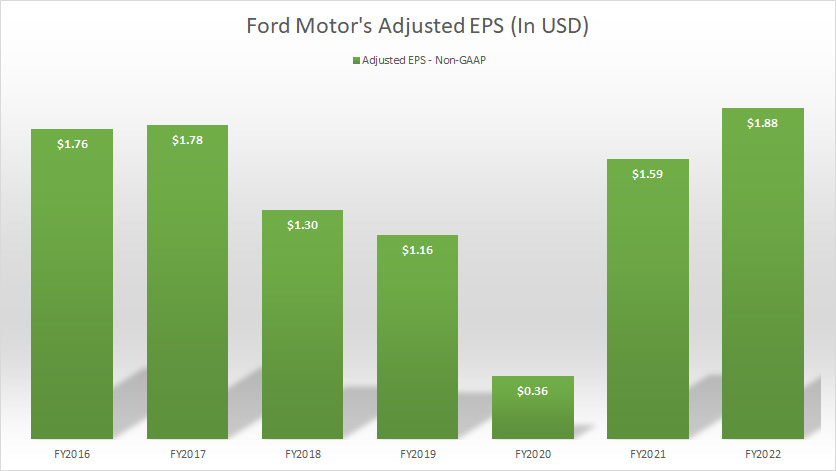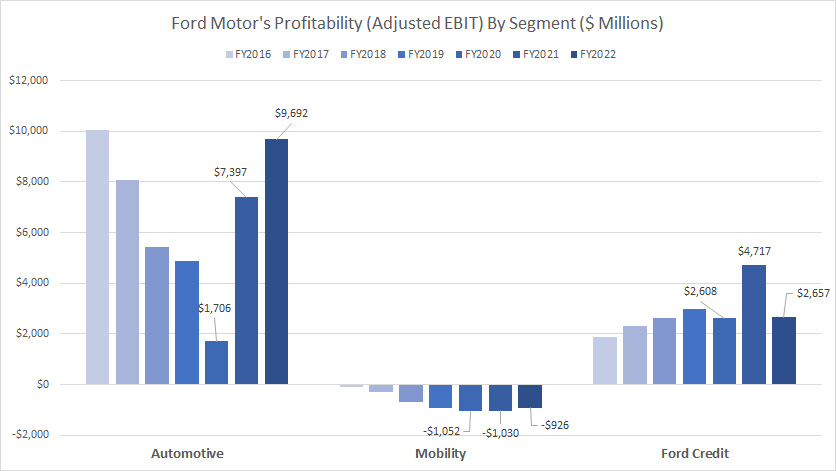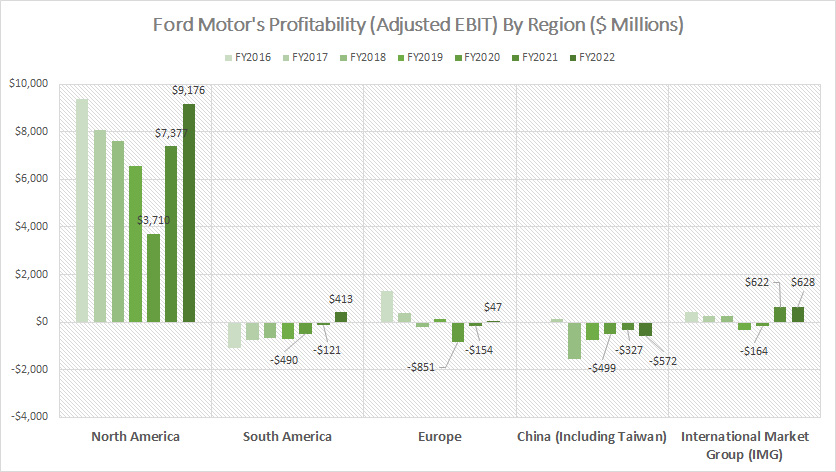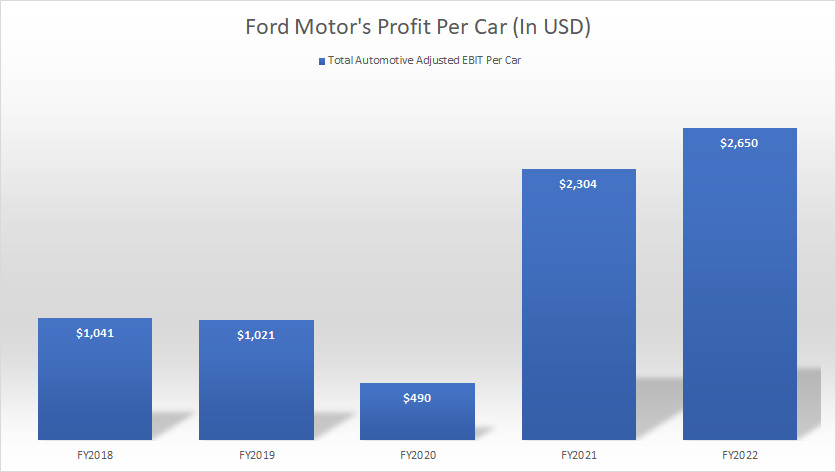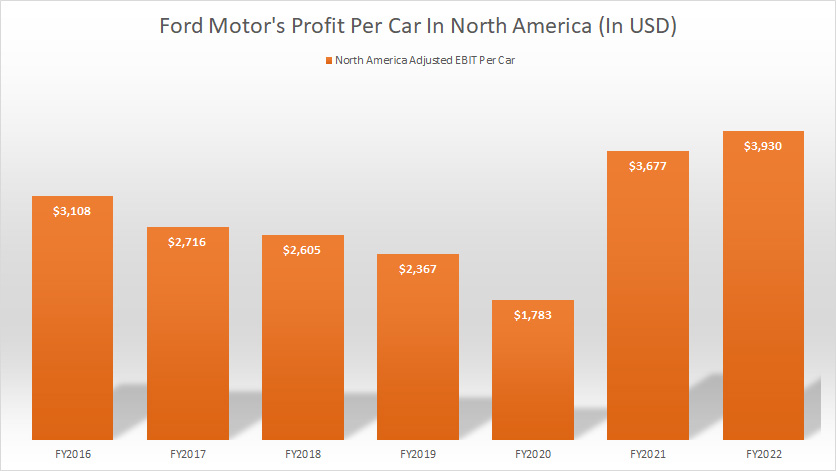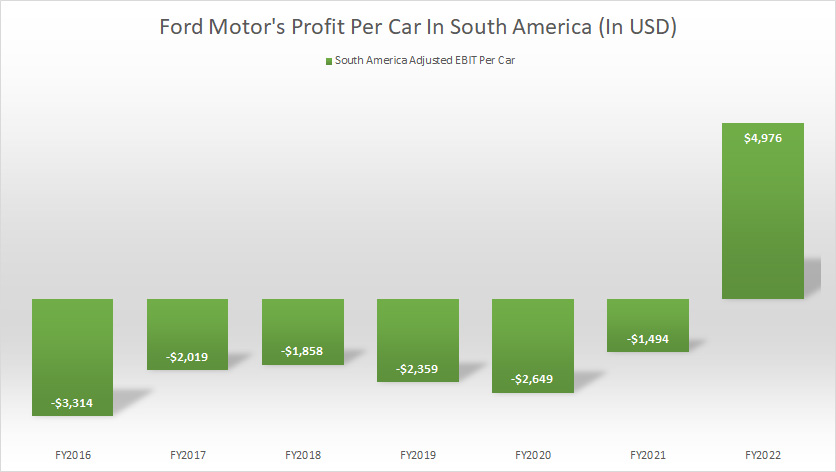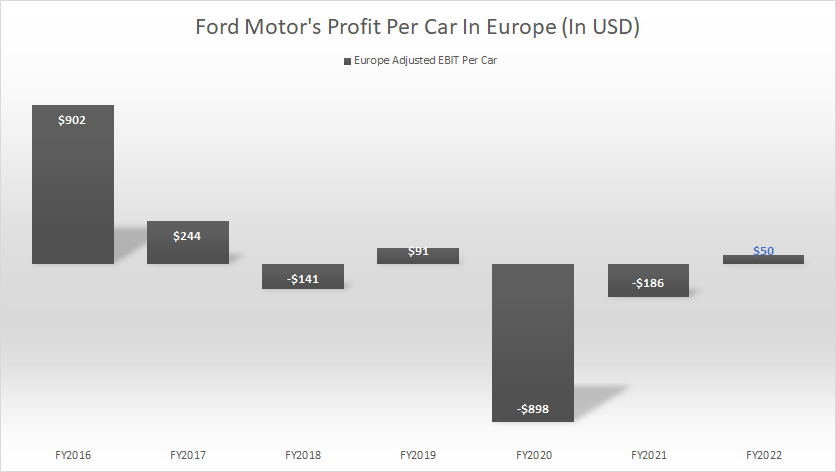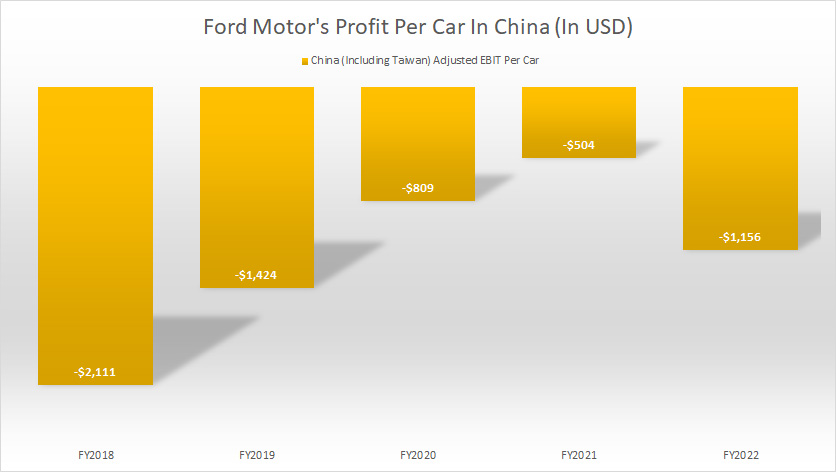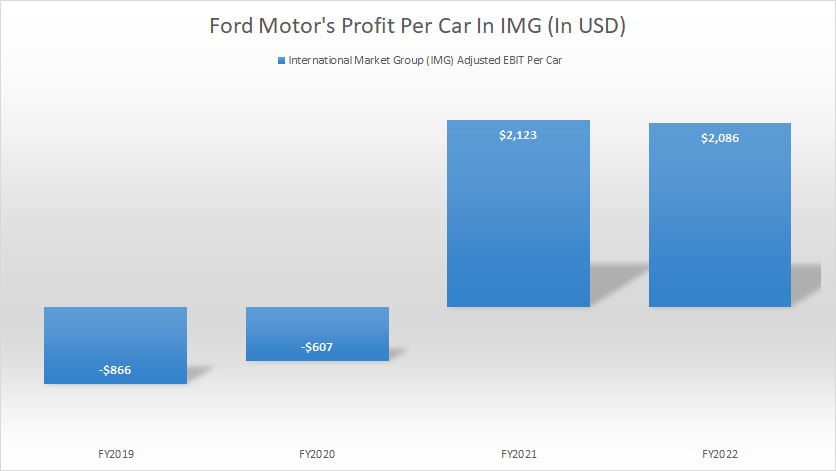
Ford Motor Company World Headquarters. Source: Flickr Image
This article presents the profitability of Ford Motor Company (NYSE:F).
We will explore several aspects of the profitability of Ford Motor, including the consolidated profit, profit by segment, profit by region and profit per vehicle.
Ford Motor must remain profitable because it pays a dividend and buys back its stocks.
Investors interested in Ford’s margins may visit this article – Ford Margins.
Let’s look at more details, starting with the table of contents below.
Table Of Contents
Consolidated Results
A1. Operating Profit
A2. Adjusted EBIT
A3. Adjusted Earning Per Share
Results By Segment
B1. Automotive, Mobility And Ford Credit
Results By Region
C1. North America, South America, Europe, China, And IMG
Results Per Car
D1. Consolidated Profit Per Vehicle
Results Per Car By Region
E1. Profit Per Vehicle In North America
E2. Profit Per Vehicle In South America
E3. Profit Per Vehicle In Europe
E4. Profit Per Vehicle In China
E5. Profit Per Vehicle In IMG
Conclusion And Reference
S1. Summary
S2. References and Credits
S3. Disclosure
Operating Profit
Ford’s operating profit
(click image to expand)
Ford Motor is a profitable company and has only reported an operating loss in fiscal 2020 over the past seven years.
Ford’s operating loss in fiscal 2020 was most likely driven by the COVID-19 disruption starting in the same year.
While Ford suffered a steep operating loss during the onset of the COVID crisis, it has quickly recovered in post-pandemic periods and reported an operating profit of more than $6 billion in fiscal 2022.
In short, Ford Motor is profitable and has produced mostly positive operating profits since 2016.
Adjusted EBIT
Ford’s adjusted EBIT
(click image to expand)
Ford uses its own metrics to measure operating efficiency.
One of these metrics is the adjusted EBIT or adjusted earnings before interest and taxes.
The adjusted EBIT excludes certain items such as interest on debt, taxes, and pre-tax items.
According to Ford, pre-tax items iclude pension and OPEB remeasurement gains and losses, significant expenses, and other items that Ford management considers unrelated to ongoing operating activities.
While the adjusted EBIT is a non-GAAP measure, Ford generally provides guidance for this metric because the excluded items are hard to predict.
As a result, the chart above includes the projection of Ford’s 2023 adjusted EBIT.
Shown in the plot above, Ford’s adjusted EBIT is projected to come in at $10 billion on average by the end of fiscal 2023, a record figure in the post-pandemic age.
Although Ford’s adjusted EBIT dived during the pandemic, it has quickly recovered in post-pandemic periods and soared to record figures in all fiscal years since 2021.
In addition, Ford has guided for a record profitability for fiscal 2023.
Again, Ford has made more money in the post-pandemic periods and may make even more money in 2023.
Adjusted Earning Per Share
Ford’s adjusted EPS
(click image to expand)
Similar to the adjusted EBIT, Ford’s adjusted EPS is a non-GAAP measure and is adjusted by Ford itself.
The adjusted EPS excludes pre-tax special items (described above), tax special items and restructuring impacts in non-controlling interest.
All told, Ford’s adjusted EPS has the same trend as that of the adjusted EBIT.
For example, Ford’s adjusted EPS dived during the COVID period but quickly recovered in the post-pandemic age.
As of fiscal 2022, Ford’s adjusted EPS totaled as much as $1.88, a record figure ever reported since fiscal 2016.
In short, Ford achieved record profitability in post-pandemic periods or the age of the EV.
Automotive, Mobility And Ford Credit
ford-profit-by-segment
(click image to expand)
Ford’s profitability by segment is evaluated based on the adjusted EBIT by segment.
Again, the adjusted EBIT by segment is a non-GAAP measure provided by Ford Motor.
That said, Ford’s Automotive and Ford Credit are the only segments that make a profit while the Mobility is unprofitable.
Ford’s Automotive generated a record profit of $9.7 billion in adjusted EBIT in fiscal 2022, the highest among all segments.
Although the profit of Ford Automotive soared to record highs in post-pandemic periods, it dived considerably during the COVID crisis in 2020 and was even lower than that of Ford Credit, indicating the vulnerability of this business segment to a black-swan event like COVID-19.
On the other hand, the profit of Ford Credit looked solid during the pandemic and did not seem to be affected.
Lastly, the Mobility segment hasn’t been a profitable segment.
North America, South America, Europe, China, And IMG
ford-profit-by-region
(click image to expand)
Ford’s profitability by region is evaluated based on the adjusted EBIT by region.
Again, the adjusted EBIT by region is a non-GAAP measure provided by Ford Motor.
That said, Ford’s Automotive in North America seems like the only region contributing a profit to the company.
In addition, North America accounts for the bulk of the profit generated under the Automotive segment, and the latest result totaled as much as $9.2 billion in adjusted EBIT.
On the other hand, other regions such as South America, Europe, and China have barely made any profit.
In particular, Ford China has incurred losses in most fiscal years, and the latest loss totaled more than $500 million in adjusted EBIT.
While North America has contributed profit to Ford, it has weaknesses.
As seen in the chart above, Ford Automotive in North America saw its profit dived during the COVID crisis, illustrating that COVID-19 or anything similar in the future can severely reduce the profit of Ford’s automotive business.
Consolidated Profit Per Vehicle
ford-profit-per-car
(click image to expand)
Ford’s consolidated profit per vehicle is evaluated based on the adjusted EBIT that we saw in prior discussions and is calculated as the consolidated adjusted EBIT divided by vehicle wholesale excluding unconsolidated affiliates.
Ford’s profit before taxes and interest expenses per vehicle totaled $2,650 in fiscal 2022 , the highest figure ever measured in the past 5 years.
The 2022 profit per car represents a rise of 15% over 2021 and a more than 400% increase from 2020.
A trend worth mentioning is that Ford’s profit per vehicle declined to only $490 per vehicle during the COVID period in fiscal 2020, indicating that future event similar to the COVID-19 can have a severe impact on Ford’s vehicle profit.
Profit Per Vehicle In North America
ford-profit-per-car-in-North-America
(click image to expand)
Ford’s profit per vehicle in North America is evaluated based on the adjusted EBIT that we saw in prior discussions and is calculated as the adjusted EBIT in North America divided by vehicle wholesale in North America excluding unconsolidated affiliates if there is any.
That said, Ford earned a profit of roughly $3,930 per vehicle in North America in fiscal 2022, probably the highest figure among all regions in Ford’s market.
Ford’s profit per car in North America has been relatively consistent, with the company making at least $2,000 per vehicle except in fiscal 2020.
A trend worth mentioning is that Ford’s profit per vehicle in North America soared significantly in the post-pandemic age, indicating the brisk business the company has been enjoying in the age of the EV.
Profit Per Vehicle In South America
ford-profit-per-car-in-South-America
(click image to expand)
Ford’s profit per vehicle in South America is evaluated based on the adjusted EBIT that we saw in prior discussions and is calculated as the adjusted EBIT in South America divided by vehicle wholesale in South America excluding unconsolidated affiliates if there is any.
In South America, Ford’s profit per vehicle in this region totaled as much as $4,976 in fiscal 2022, which was even higher than that of North America in the same period.
Although Ford earned nearly $5,000 in profit per car in South America as of fiscal 2022, the figures are inconsistent.
Before 2022, Ford’s profit per car in South America was negative, illustrating that the company was losing money for every vehicle it sold.
In short, Ford has only started becoming profitable per car sold in South America in fiscal 2022.
Profit Per Vehicle In Europe
ford-profit-per-car-in-Europe
(click image to expand)
Ford’s profit per vehicle in Europe is evaluated based on the adjusted EBIT that we saw in prior discussions and is calculated as the adjusted EBIT in Europe divided by vehicle wholesale in Europe excluding unconsolidated affiliates if there is any.
Ford barely makes any profit per car in Europe.
As of fiscal 2022, Ford earned only $50 per vehicle in profit before interest and taxes, which was hardly a profit.
Before 2022, Ford barely made any profit per car sold in Europe and was seen as having losses in most fiscal years for every vehicle sold.
Profit Per Vehicle In China
ford-profit-per-car-in-China
(click image to expand)
Ford’s profit per vehicle in China is evaluated based on the adjusted EBIT that we saw in prior discussions and is calculated as the adjusted EBIT in China divided by vehicle wholesale in China excluding unconsolidated affiliates if there is any.
Ford China is probably the region with the most significant loss for every vehicle sold.
Between fiscal 2018 and 2022, Ford produced no profit per vehicle in China. Instead, Ford’s loss per vehicle in China dwindled to more than $1,000 in fiscal 2022, the largest ever reported over the past 3 years.
Profit Per Vehicle In IMG
ford-profit-per-car-in-IMG
(click image to expand)
Ford’s profit per vehicle in IMG is evaluated based on the adjusted EBIT that we saw in prior discussions and is calculated as the adjusted EBIT in IMG divided by vehicle wholesale in IMG excluding unconsolidated affiliates if there is any.
IMG refers to regions not separately presented.
That said, Ford makes a profit of roughly $2,000 per car.
This figure came in at $2,100 in fiscal 2021 and 2022, respectively, making the IMG one of the most profitable regions in Ford’s market.
Summary
Of all the segments, Ford’s Automotive and Ford Credit produced the most profit for the company.
Similarly, with a profit of more than $3,000 per vehicle, North America accounts for most of the profit produced within Ford’s Automotive segment, making this region the most profitable among all areas in Ford’s market.
In summary, Ford is profitable in most fiscal years and has only reported a loss in one fiscal year between 2016 and 2022.
References and Credits
1. All financial figures presented in this article were obtained and referenced from Ford’s SEC filings, earning releases, quarterly and annual reports, investor presentations, etc., which are available in the following location: Ford Investors Overview.
2. Featured images in this article are used under creative commons license and sourced from the following websites: Robert GLOD and Steve Shotwell.
Disclosure
References and examples such as tables, charts, and diagrams are constantly reviewed to avoid errors, but we cannot warrant the full correctness of all content.
The content in this article is for informational purposes only and is neither a recommendation nor a piece of financial advice to purchase a stock.
If you find the information in this article helpful, please consider sharing it on social media and also provide a link back to this article from any website so that more articles like this one can be created in the future.
Thank you!

